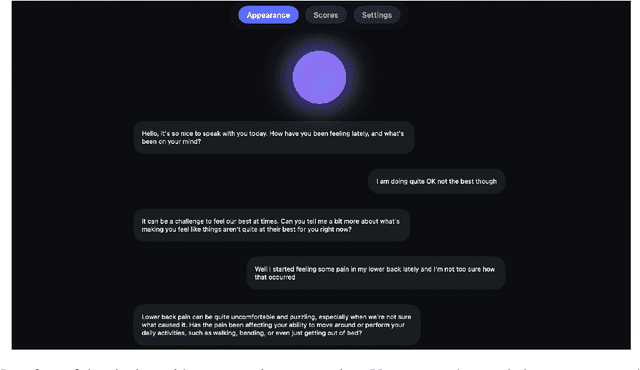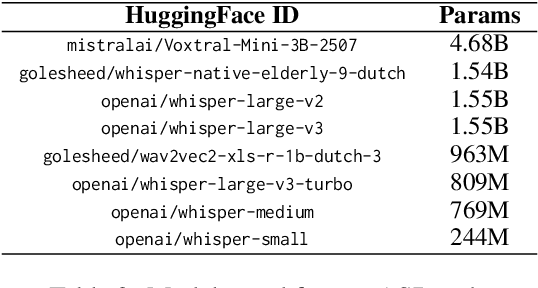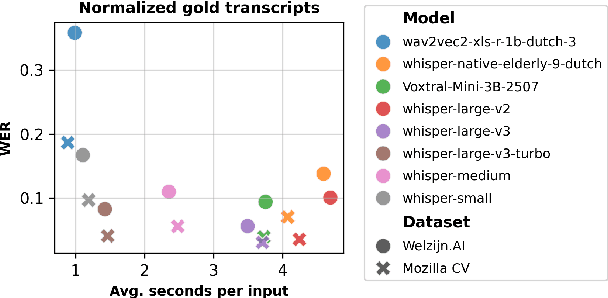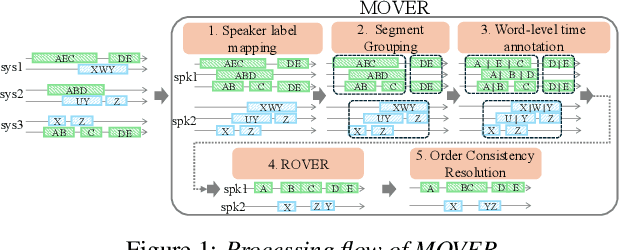speech recognition
Speech recognition is the task of identifying words spoken aloud, analyzing the voice and language, and accurately transcribing the words.
Papers and Code
Lessons Learnt: Revisit Key Training Strategies for Effective Speech Emotion Recognition in the Wild
Aug 10, 2025In this study, we revisit key training strategies in machine learning often overlooked in favor of deeper architectures. Specifically, we explore balancing strategies, activation functions, and fine-tuning techniques to enhance speech emotion recognition (SER) in naturalistic conditions. Our findings show that simple modifications improve generalization with minimal architectural changes. Our multi-modal fusion model, integrating these optimizations, achieves a valence CCC of 0.6953, the best valence score in Task 2: Emotional Attribute Regression. Notably, fine-tuning RoBERTa and WavLM separately in a single-modality setting, followed by feature fusion without training the backbone extractor, yields the highest valence performance. Additionally, focal loss and activation functions significantly enhance performance without increasing complexity. These results suggest that refining core components, rather than deepening models, leads to more robust SER in-the-wild.
Revealing the Role of Audio Channels in ASR Performance Degradation
Aug 12, 2025



Pre-trained automatic speech recognition (ASR) models have demonstrated strong performance on a variety of tasks. However, their performance can degrade substantially when the input audio comes from different recording channels. While previous studies have demonstrated this phenomenon, it is often attributed to the mismatch between training and testing corpora. This study argues that variations in speech characteristics caused by different recording channels can fundamentally harm ASR performance. To address this limitation, we propose a normalization technique designed to mitigate the impact of channel variation by aligning internal feature representations in the ASR model with those derived from a clean reference channel. This approach significantly improves ASR performance on previously unseen channels and languages, highlighting its ability to generalize across channel and language differences.
FlexCTC: GPU-powered CTC Beam Decoding With Advanced Contextual Abilities
Aug 13, 2025While beam search improves speech recognition quality over greedy decoding, standard implementations are slow, often sequential, and CPU-bound. To fully leverage modern hardware capabilities, we present a novel open-source FlexCTC toolkit for fully GPU-based beam decoding, designed for Connectionist Temporal Classification (CTC) models. Developed entirely in Python and PyTorch, it offers a fast, user-friendly, and extensible alternative to traditional C++, CUDA, or WFST-based decoders. The toolkit features a high-performance, fully batched GPU implementation with eliminated CPU-GPU synchronization and minimized kernel launch overhead via CUDA Graphs. It also supports advanced contextualization techniques, including GPU-powered N-gram language model fusion and phrase-level boosting. These features enable accurate and efficient decoding, making them suitable for both research and production use.
Out of the Box, into the Clinic? Evaluating State-of-the-Art ASR for Clinical Applications for Older Adults
Aug 12, 2025



Voice-controlled interfaces can support older adults in clinical contexts, with chatbots being a prime example, but reliable Automatic Speech Recognition (ASR) for underrepresented groups remains a bottleneck. This study evaluates state-of-the-art ASR models on language use of older Dutch adults, who interacted with the Welzijn.AI chatbot designed for geriatric contexts. We benchmark generic multilingual ASR models, and models fine-tuned for Dutch spoken by older adults, while also considering processing speed. Our results show that generic multilingual models outperform fine-tuned models, which suggests recent ASR models can generalise well out of the box to realistic datasets. Furthermore, our results suggest that truncating existing architectures is helpful in balancing the accuracy-speed trade-off, though we also identify some cases with high WER due to hallucinations.
TurboBias: Universal ASR Context-Biasing powered by GPU-accelerated Phrase-Boosting Tree
Aug 12, 2025



Recognizing specific key phrases is an essential task for contextualized Automatic Speech Recognition (ASR). However, most existing context-biasing approaches have limitations associated with the necessity of additional model training, significantly slow down the decoding process, or constrain the choice of the ASR system type. This paper proposes a universal ASR context-biasing framework that supports all major types: CTC, Transducers, and Attention Encoder-Decoder models. The framework is based on a GPU-accelerated word boosting tree, which enables it to be used in shallow fusion mode for greedy and beam search decoding without noticeable speed degradation, even with a vast number of key phrases (up to 20K items). The obtained results showed high efficiency of the proposed method, surpassing the considered open-source context-biasing approaches in accuracy and decoding speed. Our context-biasing framework is open-sourced as a part of the NeMo toolkit.
Large Language Model Data Generation for Enhanced Intent Recognition in German Speech
Aug 08, 2025Intent recognition (IR) for speech commands is essential for artificial intelligence (AI) assistant systems; however, most existing approaches are limited to short commands and are predominantly developed for English. This paper addresses these limitations by focusing on IR from speech by elderly German speakers. We propose a novel approach that combines an adapted Whisper ASR model, fine-tuned on elderly German speech (SVC-de), with Transformer-based language models trained on synthetic text datasets generated by three well-known large language models (LLMs): LeoLM, Llama3, and ChatGPT. To evaluate the robustness of our approach, we generate synthetic speech with a text-to-speech model and conduct extensive cross-dataset testing. Our results show that synthetic LLM-generated data significantly boosts classification performance and robustness to different speaking styles and unseen vocabulary. Notably, we find that LeoLM, a smaller, domain-specific 13B LLM, surpasses the much larger ChatGPT (175B) in dataset quality for German intent recognition. Our approach demonstrates that generative AI can effectively bridge data gaps in low-resource domains. We provide detailed documentation of our data generation and training process to ensure transparency and reproducibility.
Depression diagnosis from patient interviews using multimodal machine learning
Aug 26, 2025Background: Depression is a major public health concern, affecting an estimated five percent of the global population. Early and accurate diagnosis is essential to initiate effective treatment, yet recognition remains challenging in many clinical contexts. Speech, language, and behavioral cues collected during patient interviews may provide objective markers that support clinical assessment. Methods: We developed a diagnostic approach that integrates features derived from patient interviews, including speech patterns, linguistic characteristics, and structured clinical information. Separate models were trained for each modality and subsequently combined through multimodal fusion to reflect the complexity of real-world psychiatric assessment. Model validity was assessed with established performance metrics, and further evaluated using calibration and decision-analytic approaches to estimate potential clinical utility. Results: The multimodal model achieved superior diagnostic accuracy compared to single-modality models, with an AUROC of 0.88 and an F1-score of 0.75. Importantly, the fused model demonstrated good calibration and offered higher net clinical benefit compared to baseline strategies, highlighting its potential to assist clinicians in identifying patients with depression more reliably. Conclusion: Multimodal analysis of patient interviews using machine learning may serve as a valuable adjunct to psychiatric evaluation. By combining speech, language, and clinical features, this approach provides a robust framework that could enhance early detection of depressive disorders and support evidence-based decision-making in mental healthcare.
A Small-footprint Acoustic Echo Cancellation Solution for Mobile Full-Duplex Speech Interactions
Aug 11, 2025In full-duplex speech interaction systems, effective Acoustic Echo Cancellation (AEC) is crucial for recovering echo-contaminated speech. This paper presents a neural network-based AEC solution to address challenges in mobile scenarios with varying hardware, nonlinear distortions and long latency. We first incorporate diverse data augmentation strategies to enhance the model's robustness across various environments. Moreover, progressive learning is employed to incrementally improve AEC effectiveness, resulting in a considerable improvement in speech quality. To further optimize AEC's downstream applications, we introduce a novel post-processing strategy employing tailored parameters designed specifically for tasks such as Voice Activity Detection (VAD) and Automatic Speech Recognition (ASR), thus enhancing their overall efficacy. Finally, our method employs a small-footprint model with streaming inference, enabling seamless deployment on mobile devices. Empirical results demonstrate effectiveness of the proposed method in Echo Return Loss Enhancement and Perceptual Evaluation of Speech Quality, alongside significant improvements in both VAD and ASR results.
Munsit at NADI 2025 Shared Task 2: Pushing the Boundaries of Multidialectal Arabic ASR with Weakly Supervised Pretraining and Continual Supervised Fine-tuning
Aug 12, 2025Automatic speech recognition (ASR) plays a vital role in enabling natural human-machine interaction across applications such as virtual assistants, industrial automation, customer support, and real-time transcription. However, developing accurate ASR systems for low-resource languages like Arabic remains a significant challenge due to limited labeled data and the linguistic complexity introduced by diverse dialects. In this work, we present a scalable training pipeline that combines weakly supervised learning with supervised fine-tuning to develop a robust Arabic ASR model. In the first stage, we pretrain the model on 15,000 hours of weakly labeled speech covering both Modern Standard Arabic (MSA) and various Dialectal Arabic (DA) variants. In the subsequent stage, we perform continual supervised fine-tuning using a mixture of filtered weakly labeled data and a small, high-quality annotated dataset. Our approach achieves state-of-the-art results, ranking first in the multi-dialectal Arabic ASR challenge. These findings highlight the effectiveness of weak supervision paired with fine-tuning in overcoming data scarcity and delivering high-quality ASR for low-resource, dialect-rich languages.
MOVER: Combining Multiple Meeting Recognition Systems
Aug 07, 2025


In this paper, we propose Meeting recognizer Output Voting Error Reduction (MOVER), a novel system combination method for meeting recognition tasks. Although there are methods to combine the output of diarization (e.g., DOVER) or automatic speech recognition (ASR) systems (e.g., ROVER), MOVER is the first approach that can combine the outputs of meeting recognition systems that differ in terms of both diarization and ASR. MOVER combines hypotheses with different time intervals and speaker labels through a five-stage process that includes speaker alignment, segment grouping, word and timing combination, etc. Experimental results on the CHiME-8 DASR task and the multi-channel track of the NOTSOFAR-1 task demonstrate that MOVER can successfully combine multiple meeting recognition systems with diverse diarization and recognition outputs, achieving relative tcpWER improvements of 9.55 % and 8.51 % over the state-of-the-art systems for both tasks.
 Add to Chrome
Add to Chrome Add to Firefox
Add to Firefox Add to Edge
Add to Edge